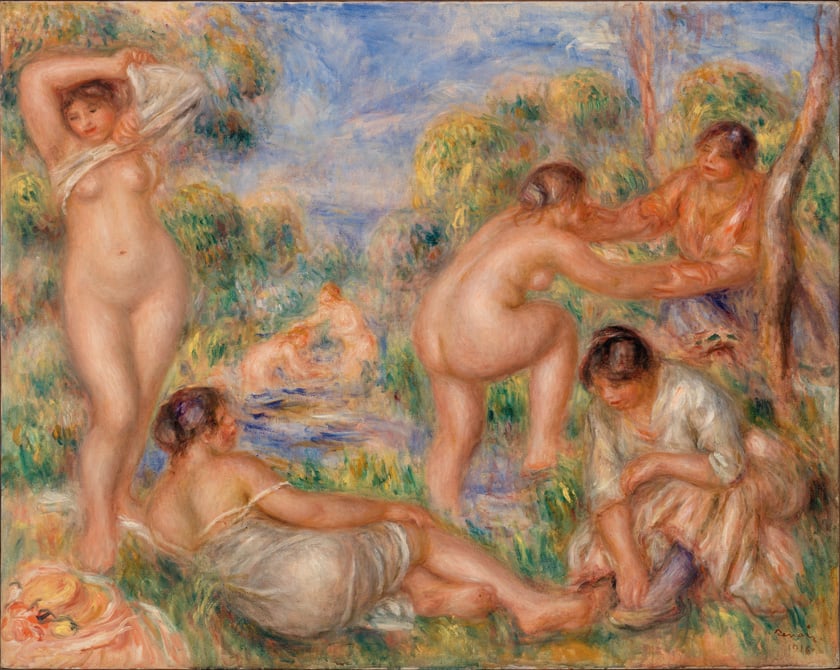What’s the deal with Leonardo’s harpsichord-viola? Why were Impressionists obsessed with the color purple? Art Bitesbrings you a surprising fact, lesser-known anecdote, or curious event from art history. These delightful nuggets shed light on the lives of famed artists and decode their practices, while adding new layers of intrigue to celebrated masterpieces.
From Just Stop Oil to Free Palestine to P.A.I.N., recent times have seen art museums coopted as staging grounds for high-minded protest.
In 2015, however, the group of protesters that picketed outside Museum of Fine Arts in Boston had a simpler, less lofty target: Pierre-Auguste Renoir. Their demand? That museums remove his paintings from their walls. Their reasoning was rather straightforward: they argued Renoir was bad at art. (A protest at New York’s Metropolitan Museum of Art was soon to follow.)
The Renoir Sucks at Painting movement (if one can call it that) was the brainchild of Max Geller, and came to life after he encountered the sizable collection of Renoir paintings at Philadelphia’s Barnes Foundation. Its central outlet is an Instagram account that features close-ups of Renoir paintings accompanied by satirical, often long-winded critiques.
Armed with snobbish hipster fury and signage that read “God Hates Renoir,” “ReNOir,” and “We’re Not Iconoclasts, Renoir Just Sucks At Painting,” the group briefly received considerable media attention—though none from the institutions it was heckling. Fellow Renoir haters expressed their aesthetic sympathy online by posting photographs of themselves giving the middle finger to Renoir paintings, often accompanied with the hashtag #renoirsucksatpainting.
Renoir haters outside Boston’s Museum of Fine Arts. Photo: Lane Turner via Boston Globe
The furor prompted Renoir’s great-great-granddaughter Genevieve Renoir to chime in. She argued the free market had spoken clearly in favor of her ancestor’s talent. The market said something that sounded like, “$78 million at Sotheby’s for Bal du moulin de la Galette na na na-na na.” Geller responded by saying the free market lacked judgement and taste, citing TV commercials, climate change, and the destruction of sea otter habitats as evidence. Fair enough.
This points to the deeper purpose of Renoir Sucks at Painting, one that was generally lost beneath the media noise and pithy takedowns. Geller wasn’t trying to censor Renoir through ridicule. He was hoping to force museums into reconsidering the artistic merits of the paintings on their walls and make change, ideally in favor of non-white male painters. He called it “cultural justice.”

Pierre-Auguste Renoir, Bathing Group (1916). Courtesy of the Barnes Collection.
Though Geller’s approach was decidedly contemporary, his root sentiment wasn’t. People have long hated Renoir. The loathing has both moral and aesthetic substance. On moral grounds, Renoir’s innumerable dumb-faced, unflattering female nudes have seen him posthumously charged with sexism. Adding to the ignominy was his anti-Semitism, as shown by his stance in the Dreyfus affair.
And yet even the aesthetic charges are somewhat personal. Renoir, a ceramicist by training, fell in with a Parisian clique that included Alfred Sisley and Claude Monet, anti-academic artists who would become part of the Impressionist movement. Bold color and depictions of modern life were in. Formalism, florid rococo details, and grand mythological scenes were out.
The problem was, Renoir quite liked these old things—“I am of the 18th century,” he once said—and when times got financially tough, he backtracked and began painting saccharine, bourgeois portraits. It made him rich, an international star even. In short, he’s seen as a sellout.
Critics argue Renoir paid no attention to line or composition (he painted as though on a pot, the charge runs) and ignored the contemporary concerns of his day. Most damning, seemingly, is the accusation that Renoir’s paintings are pretty. Good art, of course, cannot simply be pretty.
One fan of Renoir’s pretty little paintings? Donald Trump. He claims to own Two Sisters (On the Terrace). It’s a fake, mind you.
Follow Artnet News on Facebook:
Want to stay ahead of the art world? Subscribe to our newsletter to get the breaking news, eye-opening interviews, and incisive critical takes that drive the conversation forward.

